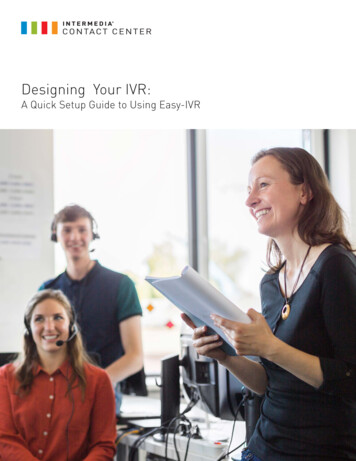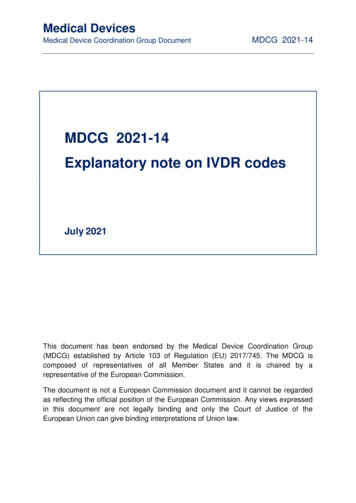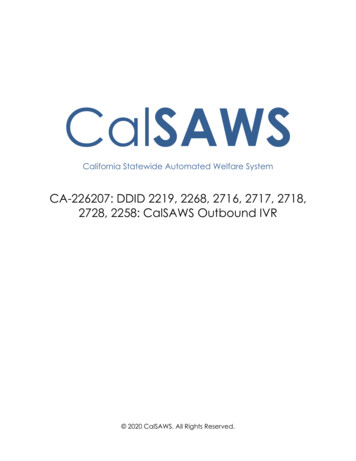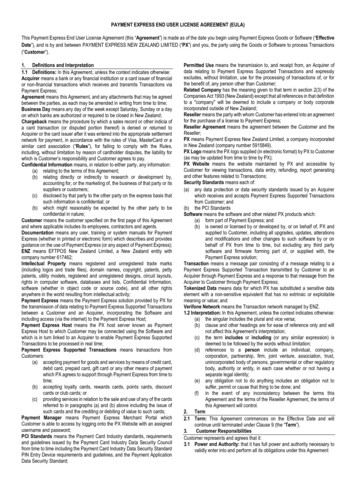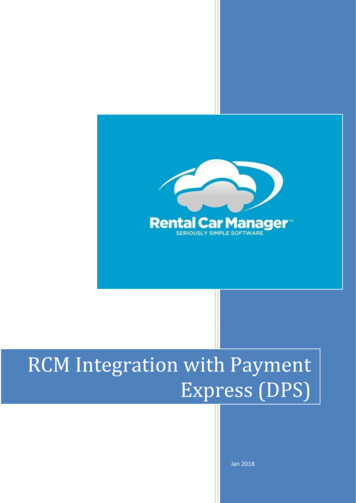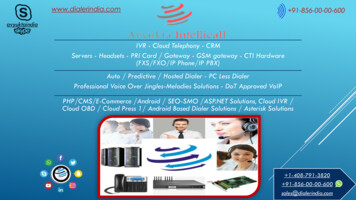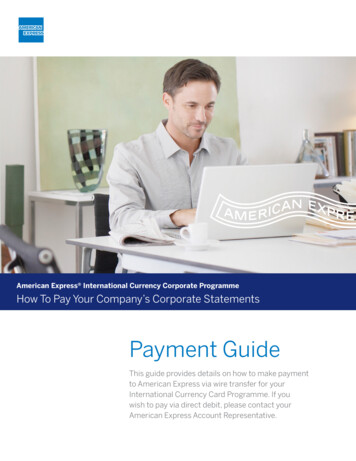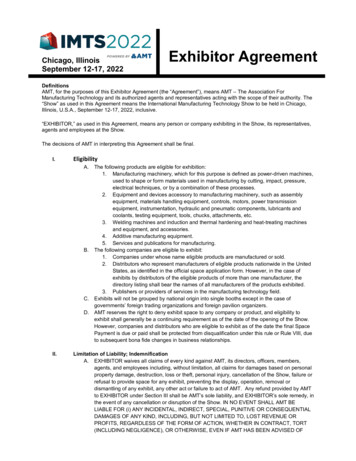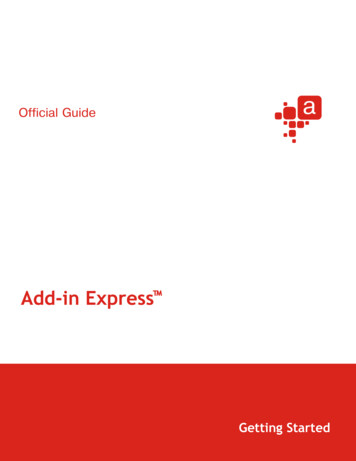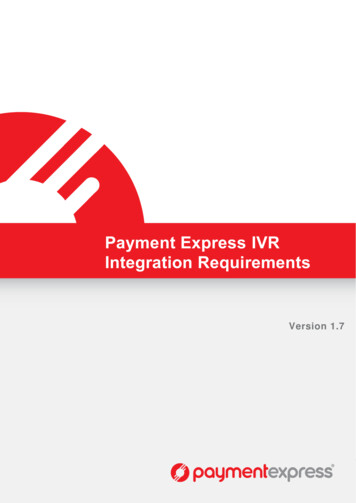
Transcription
Payment Express IVRIntegration RequirementsVersion 1.7Payment Express IVR Integration Requirements:Page 1 of 3Version: 1.7
COPYRIGHT Copyright 2018, Payment Express Limited98 Anzac AvenuePO Box 8400Auckland, 1150New Zealandwww.paymentexpress.comAll rights are reserved. No part of this work may be reproduced or copied in any form or by any means, electronic ormechanical, including photocopying, without the express written permission of Payment Express Limited.PROPRIETY NOTICEThe information described in this document is proprietary and confidential to Payment Express Limited. Any unauthoriseduse of this material is expressly prohibited except as authorised by Payment Express Limited in writing.
CONTENTS12Introduction . 11.1Background and Overview . 11.2Assumptions. 1Call Script Process flow . 22.1Customisation of the standard call script . 52.2Session Initiated IVR . 63Audio File Requirements . 84Transaction Outcomes . 104.1Payline . 104.2Auto reports . 104.3Real-time Notification . 105Limitations . 116Testing . 117Appendix . 12General Glossary . 12
1 INTRODUCTION1.1BACKGROUND AND OVERVIEWThe Payment Express IVR provides the ability for a merchant to take phone based payments inside of a PaymentExpress PCI compliant environment. The call scripts used are configurable and may be varied on a per customer basis.The purpose of this document is to show the default call script and to provide a starting point for merchants to designtheir own call scripts. Merchants wishing to customise their call script will need to consult their allocated ImplementationConsultant at Payment Express to verify their requirements are able to be met.1.2ASSUMPTIONSRefA01A02AssumptionWhen transferring a call to the PaymentExpress IVR the merchants system will fullyde-trombone the call.It is preferred that DTMF tones will bereceived by the Payment Express system outof band.Payment Express IVR Integration Requirements:Page 1 of 12ReasonFailure to do so will mean DTMF tones pass through themerchants system and therefore leave them in scope forPCI requirementsOut of band DTMF tones are preferred as this removesrisk of voice data being misinterpreted as DTMF tones,however we can work with in band DTMF tones ifrequired.Version: 1.7
2 CALL SCRIPT PROCESS FLOWThis section documents the Call script process flow of the standard (off the shelf Payment Express IVR)High level with Entry pointCapturing the Transaction ReferenceVersion: 1.7Page 2 of 12
Capturing the Transaction AmountCapturing the Credit card numberVersion: 1.7Page 3 of 12
Capturing the Card Expiry DateCapturing the Card Verification or Security Code (CVC or CSC)Version: 1.7Page 4 of 12
Processing the Payment2.1CUSTOMISATION OF THE STANDARD CALL SCRIPTAlterations to the call script may be made as necessary; however any such alterations will impact the developmenttimeframes. It is expected that in most cases merchants will require a way of matching or importing a transaction intotheir system. This may be achieved by providing additional references for a transaction that is returned in the transactionresult. This could be a customer Id or perhaps an invoice number. Or the call flow option to save the card. In thisscenario we recommend altering ‘1.0 Entry Point’ to give a general overview of the process flow and insert a new callflow similar to the flow ‘1.1 Capture Reference’ shown above.Another common requirement is to have a merchant-provided unique identifier for a transaction. The call script can bestructured at the 1.0 Entry Point to have the numeric data, as DTMF tones, passed in by the merchants system beforetransferring the call thus making this step invisible to the cardholder entering their card details. Alternatively a promptmay be added to ask the cardholder to provide the reference (such as an invoice Id). The timeout duration and retrycounts can also be configured per call flow.So the functionality of the IVR call flows can be customised to suit the merchant’s needs on a case by case basis.Additional charges may apply, please contact one of our Sales representatives (sales@paymentexpress.com) for moreinformation. Preferably the low level prompts shown in the call flows above would not need to be changed but the needmay arise to obtain additional input parameters from the cardholder. It is suggested that any additional prompts appearbefore the prompts to capture card information.If this is required please document the changes to process flow as above and supply revised diagrams with details toyour Payment Express Implementation Consultant (once available and project has been initiated) for verification. This willalso ensure the custom IVR solution can be efficiently implemented by the Payment Express Development team.Version: 1.7Page 5 of 12
2.2SESSION INITIATED IVRInstead of initiating the IVR transaction when the call to our IVR is connected, alternatively the merchant’s system cansend an API request with the transaction details such as merchant references and amount. The API response to themerchant’s system will contain a Payment Express generated session ID for the transaction to occur via IVR. Themerchant’s system will dial the Payment Express IVR and transmit the session ID as DTMF tones to the connected IVRcall. The IVR call flows proceeds where the customer is prompted to enter the card details for the payment to beprocessed on the session ID.This allows the call flows to capture the reference and amount to be skipped as those transaction request details arealready associated with the session ID.1.The merchant’s system sends a create session request with the transaction details (such as amount,transaction reference, merchant’s notification URL, etc) using the Payment Express API. The APIdocumentation will be provided on request.The API credentials for testing and live usage will provided by our Support team on request.2.The valid create session API request will return the session Id for the merchant to capture.3.The merchant’s system extracts the last 16 characters of the session ID and converts the last 16 characters todecimal numbers (in base-10).4.The merchant’s system dials the Payment Express IVR phone number, when the call is connected, merchant’ssystem passes the decimal numbers of the session ID as DTMF tones.5.After the merchant’s system transfers the call to the customer, the customizable call flows (shown above)contains various steps to prompt the card details.Version: 1.7Page 6 of 12
6.Once the transaction is processed, the merchant’s system receives a notification to the URL specified in step 1above. The notification received to the merchant system contains the transaction outcome. Alternatively onreceiving a notification the merchant system can also query the full original session ID using the PaymentExpress API query session request.The standard call flows for the session initiated IVR are below. The Capture Card details call flow remain the same asper call flow diagrams numbered 1.3 to 1.5.Entry Point with SessionIdProcess Payment for the Session Initiated IVRVersion: 1.7Page 7 of 12
3 AUDIO FILE REQUIREMENTSEach of the Prompts in the call script will require one or more audio files to be played. It is expected that the PaymentExpress customer requesting the IVR will supply similar files named accordingly. The Call script prompts below are aguide and the customer may choose to alter the prompt’s wording for a given file provided the change does not influencethe expected behaviour of the cardholder at the given prompt. Alternatively, a text to speech option is available forcustomers not wishing to provide their own custom voice files. It is recommended that files have consistent quiet spaceat beginning and end so that when numbers are being played back to cardholders the speech pattern is consistent.The audio file format and metadata should be exactly 16-kHz LPCM @ 16-bits/sample.Call Script PromptsPrompt1.0-11.1-11.1-2File wavCall ScriptWelcome to Merchant Name IVR.Please enter your transaction reference, followed by the # key.The reference number you have entered is transaction reference .If this is correct, press the # key. To re-enter the transactionreference, press the * key.We are sorry, we have not detected your input.The transaction reference entered is invalid.The input you have entered is invalid.Please enter the amount you wish to pay followed by the # key.The amount to pay you have entered is pay amount . If this iscorrect, press the # key. To re-enter the pay amount, press the *key.The amount entered is invalid.Please enter your credit card number, followed by the # key.The card number you have entered is card number . If this iscorrect, press the # key. To re-enter the card number, press the *key.The credit card number you have entered is invalid.Please enter the card’s expiry date in month month, year yearformat followed by the # key.The expiry date entered is expiry date . If this is correct, press the# key. To re-enter the expiry date, press the * key.The expiry date you have entered is invalid.Please enter your card security code followed by the # key. This isusually located on the back of your card.The CVC code you have entered is CVC code . If this is correct,press the # key. To re-enter the CVC code, press the * key.The card security code you have entered is invalid.Please wait while your transaction is processed.Thank you. Your transaction has been approved.I am sorry, your transaction has been declined. Your credit card hasnot been charged.Your authorisation number is authorisation number .We are sorry but you have exceeded the maximum number ofattempts. Thank you for using this service, goodbye.If you wish to make another payment, press the # key again,otherwise hang up now.Thank you for using this service, goodbye.The amount to pay you have entered is pay amount .Version: 1.7Page 8 of 12
Playback SixthSeventhEighthFile Fifth.wavSixth.wavSeventh.wavEighth.wavCall venthEighthVersion: 1.7Page 9 of 12
Notes:* Should be read as “star”# should be read as “hash”4 TRANSACTION OUTCOMESIVR transactions take place on the Payment Express system; therefore the need arises to have mechanisms that willallow the Merchants system to become aware of transactions that have been processed. There are various optionsavailable to achieve this.4.1PAYLINEA user account to log into the Payment Express Payment Manager portal to view the transaction details processed.Transaction Reports can also be generated and downloaded through the portal.4.2AUTO REPORTSA Report that contains transactions processed on a merchant account may be generated and sent on a periodic basis(usually daily). The method of delivery is optional between SFTP and email. Please contact one of our Salesrepresentatives (sales@paymentexpress.com) for more information.4.3REAL-TIME NOTIFICATIONA real-time notification response after the IVR transaction may be generated with the transaction details and sent to anAPI endpoint or web server hosted by the merchant. This option allows a merchant to update their system in real timewith transaction outcomes. The notification with the transaction outcome details can be sent as HTTPS POST with theJSON payload. For the notification sent as a SOAP payload there is additional development and customisation taskrequired by our Development team.The transaction outcome information is within the notification payload. It is recommended to record these details yourown system’s transaction outcome details.Version: 1.7Page 10 of 12
Following are the common transaction outcome fields:MerchantReference - this is a merchant generated reference for the transaction if one is required - if needed thereference would need to be passed via DTMF tones at the beginning of the call to the Payment Express (PX) IVR.TxnRef - a Transaction Reference can be generated by the merchant - passed via DTMF tones. If not, then PaymentExpress will generate one, so there will always be a TxnRef.Transaction Id or DpsTxnRef - always generated for every transaction on the Payment Express gateway. This is aunique identifier for the transaction on our system - this is the best way to identify an individual transaction whentroubleshooting or resolving an issue so your application should include it in your system’s transaction outcome details.BillingId - a merchant generated token used for card tokenization - passed via DTMF tones at the beginning of the callto the PX IVR.CardId or DpsBillingId - a PX generated token used for card tokenization that is always returned if tokenization isenabled.CardNumber2 - A card token generated by Payment Express when saving or tokenizing a card for recurring billing.CardNumber2 is a 16 digit number which conforms to a Luhn 'mod 10' algorithm and has a 1-to-1 relationship with theactual card number used. Please contact Payment Express support if you would like to use this value.ReCo - Response Code. A successful transaction will have '00' as the response code.AuthCode - this is the reference passed from the Merchant’s Bank confirming Authorisation of the transaction by theCard Issuing Bank.TxnData1, TxnData2, TxnData3 - optional reference fields for a given transaction that the merchant can use if required would be set by the merchant and passed via DTMF tones at the beginning of the call to the PX IVR.5 LIMITATIONSThe IVR can accept / allow the cardholder to input buttons over the top of the audio files. However, only the last audio filein a prompt (that contains a sequence of audio files) may be skipped by user input.6 TESTINGOnce a test version of your IVR solution has been deployed in our UAT environment, you will need to test the IVRsolution to confirm that it meets your requirements and expectations. It is recommended that this testing replicates asmuch as possible the expected behaviour in any of your systems that receive the IVR transaction outcomes.A test IVR will be made available for the merchant to perform UAT validation that the IVR meets their agreed uponrequirements. Once the Merchant has signed off the IVR requirements they may request the IVR scripts be deployed intothe production environment. The environment will remain available for 5 working days following the productiondeployment. After which it may be taken down and made available to other merchants waiting for development testing.Version: 1.7Page 11 of 12
7 APPENDIXGENERAL GLOSSARY:TermDescriptionAPIApplication Programming Interface.AssumptionA condition not certain to happen, outside the control of the project, and necessary for theproject or solution to be successful.DTMFDual-Tone Multi-Frequency. Dual-tone multi-frequency signalling is an in-bandtelecommunication signalling system using the voice-frequency band over telephone linesbetween telephone equipment and other communications devices and switching centres.IVRInteractive Voice Response.PCIPCI DSS is a comprehensive set of requirements created by the Payment Card IndustrySecurity Standards Council for enhancing cardholder data security and to ensure the safehandling and storage of sensitive customer credit card information / data.UATUser Acceptance Testing.Version: 1.7Page 12 of 12
Instead of initiating the IVR transaction when the call to our IVR is connected, alternatively the merchant's system can send an API request with the transaction details such as merchant references and amount. The API response to the merchant's system will contain a Payment Express generated session ID for the transaction to occur via IVR. The


